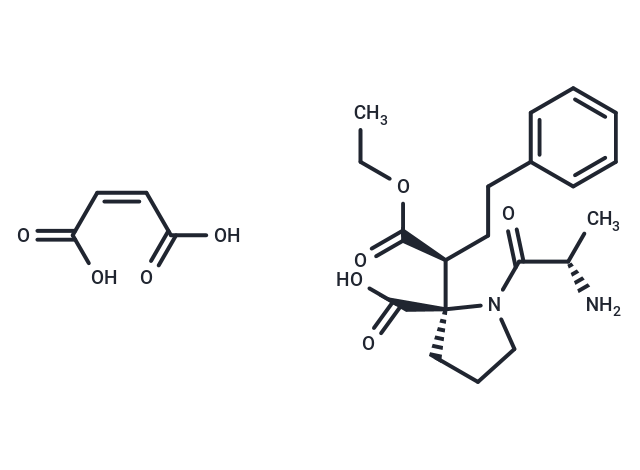Shopping Cart
- Remove All
 Your shopping cart is currently empty
Your shopping cart is currently empty

Enalapril Maleate (MK-421 Maleate), an angiotensin-converting enzyme (ACE) inhibitor, is utilized in the treatment of hypertension, chronic heart failure , and diabetic nephropathy.

| Pack Size | Price | Availability | Quantity |
|---|---|---|---|
| 1 g | $42 | In Stock |
| Description | Enalapril Maleate (MK-421 Maleate), an angiotensin-converting enzyme (ACE) inhibitor, is utilized in the treatment of hypertension, chronic heart failure , and diabetic nephropathy. |
| In vitro | Enalapril?is rapidly converted by ester hydrolysis to enalaprilat, a potent ACE?inhibitor;?Enalapril?itself is only a weak ACE?inhibitor.?Enalapril?lowers peripheral vascular resistance without causing an increase in heart rate.?[1] |
| In vivo | Enalapril?treatment?abolishes the deleterious effects of?eNOS?deficiency on blood pressure (BP),?atherosclerosis, and?kidney dysfunction?in nnee?mice. [2] Enalapril?causes a dose-dependent increase in fore limb strength?in the?mdx?mouse. Enalapril?causes a dose-dependent reduction of superoxide anion production?in tibialis anterior?muscle?of the?mdx?mouse as observed by dihydroethidium staining.?Enalapril?(5 mg/kg) reduces the area of?muscle?necrosis in both gastrocnemious?muscle?and diaphragm, without significant effect on non-muscle?area. [3] Enalapril Maleate results in significant increases in kidney weight and in concentrations of urinary albumin, N-acetyl-fl-d-glucosamidase (NAG) and serum ET-1 in streptozotocin (STZ)-induced?diabetic (STZ-DM)?rats as compared with the non-diabetic?rats, and the concentration of ET-1 in the kidneys tended to be increased. Enalapril Maleate results in increased mesangial cell proliferation, matrix expansion and enlarged mesangial area in the kidney of the?diabetic?rats.?Enalapril Maleate reduces increased concentrations of urinary albumin and NAG in the STZ-DM?rats to the control values with a slight improvement in the electron microscopic?changes.[4] |
| Kinase Assay | Single displacement binding assay: The binding assay is based on the competitive displacement of [125I]351A by Enalaprilat performed on whole endothelial cells. Subconfluent HUVECs in 6-well plates are rinsed with 2 mL binding buffer (140 mM NaCl, 2.7 mM KCl, 1.8 mM CaCl2, 1.03 mM MgCl2, 0.42 mM NaH2PO4, 10 mM HEPES, 2 mM sodium pyruvate and 5 mM glucose, pH 7.4), and the culture medium is replaced with 2.5 mL fresh binding buffer containing 5% fetal bovine serum (FBS). The Enalaprilat (2.5-12.5 μL, 0.1-50 nM) or equivalent volumes of diluent are added to the binding buffer. A saturating amount of [125I]351A (10 μL, typically 106 cpm) is then added to each sample and the plates are incubated at 37 °C for 2 hours in a thermostatic bath. The cells are then rinsed twice with 1.5 mL binding buffer. Finally, the cells are extracted with 0.5 mL NaOH 1 N, incubated for 5 minutes, and the radioactivity is counted with a gamma counter. The ratio of specific [125I]351A bound to total bound activity (B/B0) is calculated, and the inhibitory potency of Enalaprilat expressed as the concentration of ACE inhibitors able to displace 50% of the bound radioligand, i.e. the IC50. |
| Alias | Vasotec Maleate, Renitec Maleate, MK-421 Maleate, MK-421 (maleate), Glioten Maleate |
| Molecular Weight | 492.52 |
| Formula | C20H28N2O5·C4H4O4 |
| Cas No. | 76095-16-4 |
| Smiles | OC(=O)\C=C/C(O)=O.CCOC(=O)[C@@H](CCc1ccccc1)[C@]1(CCCN1C(=O)[C@H](C)N)C(O)=O |
| Relative Density. | no data available |
| Storage | Powder: -20°C for 3 years | In solvent: -80°C for 1 year | Shipping with blue ice. | |||||||||||||||||||||||||
| Solubility Information | Ethanol: 4 mg/mL (8.12 mM), Sonication is recommended. DMSO: 6.88 mg/mL (13.96 mM), Sonication is recommended. H2O: < 1 mg/mL (insoluble or slightly soluble) | |||||||||||||||||||||||||
Solution Preparation Table | ||||||||||||||||||||||||||
Ethanol/DMSO
DMSO
| ||||||||||||||||||||||||||

Copyright © 2015-2025 TargetMol Chemicals Inc. All Rights Reserved.